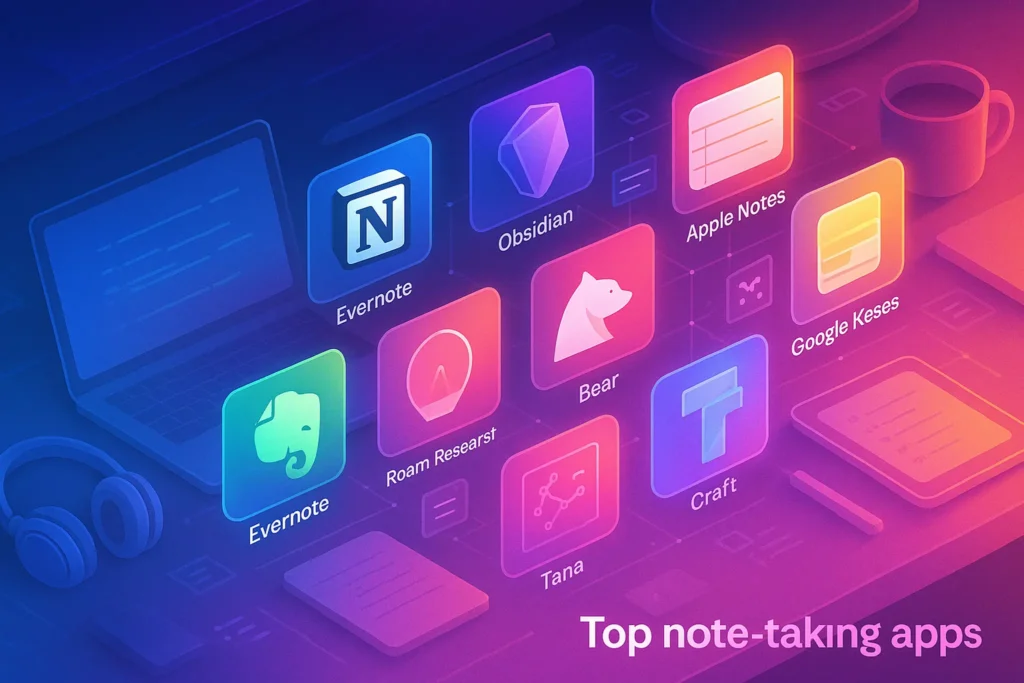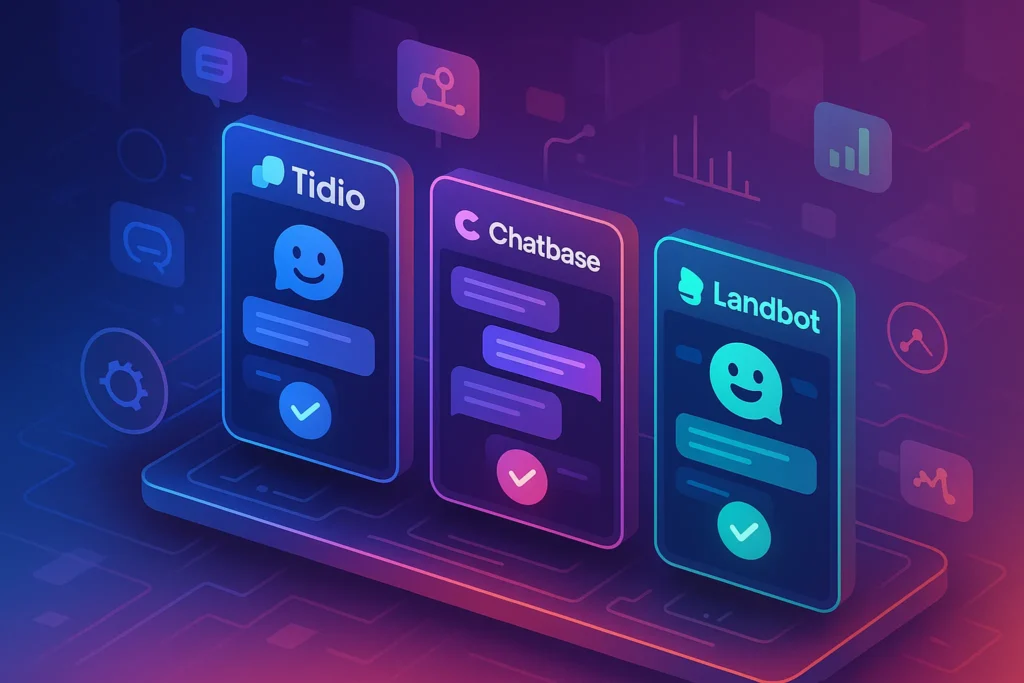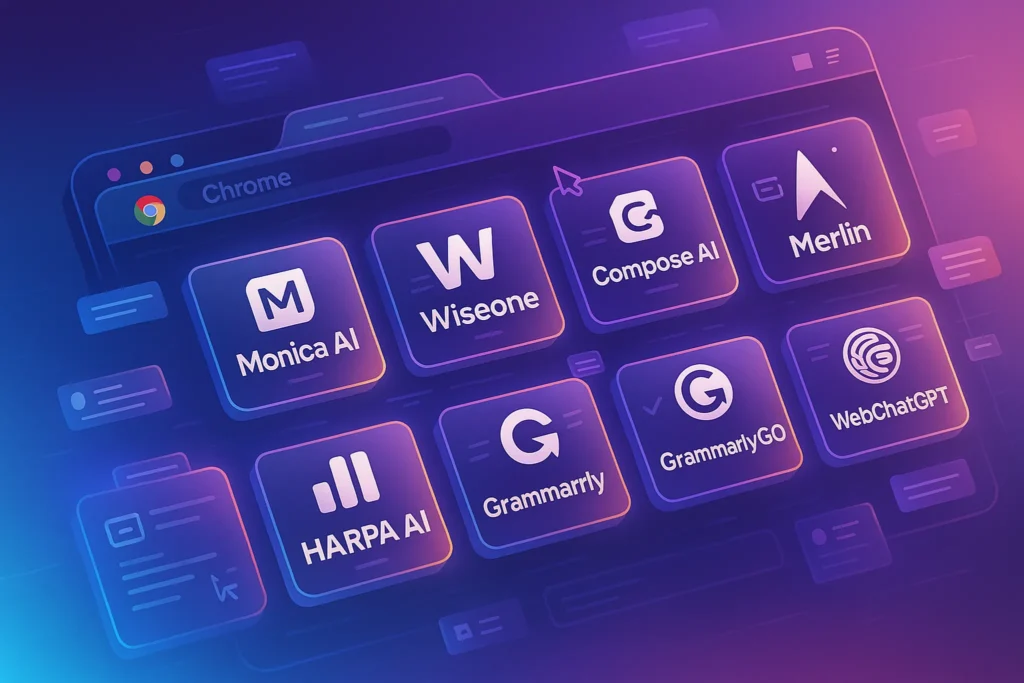-This post may contain affiliate links. If you click on one and make a purchase, I may earn a small commission at no extra cost to you.-
🧭 Introduction
In 2025, note-taking is no longer just jotting down thoughts—it’s about building knowledge, collaborating seamlessly, and even tapping into AI insights. From traditional powerhouses like Evernote and OneNote to newcomers like Obsidian and Google’s NotebookLM, the modern landscape offers diverse tools suited to different workflows. Whether you’re studying, building a Second Brain, or managing a creative project, this roundup reviews the top 10 apps—covering free tiers, paid tiers, recent updates, and who each tool is best for.
📊 How We Chose These Apps
We analyzed recent reports from Tom’s Guide, TechRadar, Zapier, and The Verge, cross-referencing with user reviews and personal testing. Key evaluation criteria:
-
Ease of capture (text, audio, web clips)
-
Organization & search
-
AI-powered features and integrations
-
Pricing tiers and value
💡 App Highlights & Recent Features
🌟 Evernote
A longtime favorite for quick capture, Evernote shines with its AI-powered note assistant, offering instant summaries, tag suggestions, and dashboard widgets for lists, calendars, and timers—now available even offline. Recent updates have improved syncing speed, mobile editing, and notebook performance. Its OCR tech—especially for handwriting and scanned documents—still sets it apart. If you juggle research, receipts, and handwritten notes, Evernote delivers powerful capture and retrieval with minimal friction.
Still the go-to for instantaneous capture and OCR of images, PDFs, and handwritten notes. Its premium “Smart Search” across handwritten and image text remains unmatched, and the legacy interface—folders and stacks—feels familiar for paper-based thinkers.
✅ Pros:
-
Excellent OCR for scanned docs and handwriting
-
Cross-platform sync and clean UI
-
Smart suggestions and note templates
❌ Cons:
-
Limited free plan (only 1 notebook + 50 notes)
-
Slower updates in recent years
-
Expensive Premium tier compared to alternatives
🛠️ Notion
In 2025, Notion is more than a note app—it’s an AI-enhanced work OS with features like summaries, database setup, and meeting note cleanup right inside your workspace. Recent features include integrated email (Notion Mail), calendar, and planning templates—perfect for centralizing life and work. Powerful AI creates databases, drafts content, and answers questions within your pages. If you’re creating a Second Brain or managing teams, Notion offers unparalleled flexibility and intelligence.
A versatile workspace combining notes, databases, and embedded AI features. In 2025, Notion AI now summarizes content, drafts messages, and supports Databases + Calendar workflows—ideal for Second Brain systems.
✅ Pros:
-
All-in-one workspace with powerful databases
-
Integrated Notion AI for writing, summarizing, and editing
-
Massive template library and strong community
❌ Cons:
-
Learning curve for new users
-
Offline support still limited
-
Mobile editing less fluid than desktop
📓 OneNote
A free-tier cornerstone for Microsoft 365 users, OneNote blends audio, sketching, and typed notes with Copilot AI features that extract key actions and summaries from lectures or meetings. It’s a digital notebook that keeps pace with its analog counterpart—ideal for multimedia-heavy workflows and deep integrations with Word, Outlook, and Teams
Free with robust Office 365 integration—perfect for embedding media, sketches, and collaboration. Copilot-powered tools now help summarize notebooks and extract action items.
✅ Pros:
-
Free with Microsoft 365, robust multimedia support
-
Copilot AI auto-summarizes meetings and classes
-
Familiar notebook-style structure
❌ Cons:
-
UI feels outdated compared to newer tools
-
Syncing issues occasionally reported
-
Lacks built-in task automation
🗂️ Google Keep
For those who prefer simplicity, Google Keep delivers. Sticky-note style cards with reminders, voice transcription, shortcuts, and Drive sync make it ideal for fleeting thoughts or task capture. It’s not for structured workflows, but it excels at speed and accessibility—especially on mobile devices .
Easy-to-use, card-style notes with location-based reminders and integration with Google Drive. It won’t build your Second Brain—but it’s ideal for quick ideas and checklists.
✅ Pros:
-
Super simple and fast
-
Location- and time-based reminders
-
Seamless with other Google services
❌ Cons:
-
No folder or hierarchy system
-
Not suitable for longform or structured notes
-
Limited formatting options
🧠 Obsidian
Markdown-based, offline, and privacy-first—Obsidian thrives on bi-directional linking and graph views that visualize your idea network . Users highlight its ability to uncover connections between supposedly disparate notes. Ideal for long-term thinking, researchers, and creators who explore non-linear thought systems.
Markdown-based, self-hosted vault with live linking and graph views for visualizing connections. Perfect for personal researchers and networked thinkers.
✅ Pros:
-
Offline-first with full data ownership
-
Bi-directional links + visual graph
-
Massive plugin community for customization
❌ Cons:
-
No native sync unless you pay
-
Best for power users—overkill for casual note-takers
-
No built-in AI (without plugin workarounds)
🔐 Joplin
Open-source, encrypted, and offering a clean Markdown interface, Joplin is perfect for privacy-conscious users. It includes web clippers, offline use, and local-first syncing. It lacks flashy AI—but for users who value control, openness, and portability, it checks all essential boxes
Open-source and encrypted, supporting Markdown, offline-first syncing, and web clippers—excellent for privacy-first users.
✅ Pros:
-
Free and open-source with end-to-end encryption
-
Markdown support + strong export options
-
Web clipper and plugin system
❌ Cons:
-
UI less polished than mainstream apps
-
Sync setup is manual (Nextcloud, Dropbox, etc.)
-
Not beginner-friendly
✍️ Nebo
Designed for stylus users, Nebo excels in hand-to-text conversion and diagramming with ultra-high accuracy—ideal for tablet note-takers. It turns messy handwriting into clean type and structured content, making sketch-heavy note-takers feel more productive .
Handwriting-to-text on tablets with diagram support. A solid one-time purchase option for stylus users.
✅ Pros:
-
Excellent handwriting recognition and math input
-
Exports to Word, PDF, or Markdown
-
One-time cost—no subscriptions
❌ Cons:
-
Limited to iPad/tablets with stylus
-
No collaboration or sharing tools
-
Not ideal for typed notes or database-style organization
🗒️ Simplenote
True to its name, Simplenote offers clean, lightweight text editing with speedy search—perfect for journaling or ultra-simple note capture. No clutter, no bounce—just efficient writing and instant syncing .
Lightweight and focused, it shines for fast text entry and search—no fluff.
✅ Pros:
-
Distraction-free interface
-
Lightweight and lightning fast
-
Syncs across platforms effortlessly
❌ Cons:
-
Only plain text—no images or file attachments
-
No folders or rich note formatting
-
Lacks integrations and automation
📄 Dropbox Paper
Built for collaboration and media-rich notes, Dropbox Paper supports image, audio, and video embedding directly inside documents. It’s ideal for creative teams working on shared ideas, especially alongside Dropbox file storage .
Media-rich collaborative docs with live editing. Great for creative team workflows .
✅ Pros:
-
Rich media embedding (audio, video, etc.)
-
Great for collaboration and project docs
-
Free with Dropbox account
❌ Cons:
-
Fewer note organization features
-
Not ideal for personal note-taking
-
Formatting can feel clunky
🍎 Apple Notes
Syncing seamlessly across iOS and macOS devices, Apple Notes now supports handwriting, scanning, document markup, and rich text—all for free. It’s perfect for Apple-centric users who want a reliable, accessible, synchronized note system without extra apps or subscriptions .
Feature-rich for iOS users—supports rich text, scanning, and stapling attachments with secure sync.
✅ Pros:
-
Deep iOS/macOS integration
-
Easy sketching, scanning, and file embedding
-
Offline and private by default
❌ Cons:
-
Apple-only ecosystem
-
No advanced tagging or linking features
-
Not suitable for complex workflows
🔗 Build Smarter
If you’re a student or knowledge worker, see Best AI Note‑Taking Apps for Students—then scale your system with Notion or Obsidian. And if you’re honing a Second Brain, revisit our deeper framework in Ultimate Guide to Building a Second Brain to structure your chosen app effectively.
❌ Choosing the Right App: Pitfalls to Avoid
-
Don’t choose complexity over consistency. If you’re uncomfortable, Notion might overwhelm—start with Evernote or Simplenote.
-
Beware of vendor lock-in. Export options vary; favor tools that let you own your data (like Joplin or Obsidian).
-
AI isn’t magic—structure matters. Auto-summaries need intentional organization to be useful.
🧠 What Makes a Great Note-Taking App in 2025?
The best note-taking tools in 2025 aren’t just about taking notes—they’re about managing information flow. Whether you’re a student, entrepreneur, or knowledge worker, modern note apps must do more than just store text.
Here’s what sets top performers apart:
1. AI-Powered Assistance
AI isn’t optional anymore. From summarizing lecture notes to auto-tagging your research files, modern tools must do the heavy lifting. Notion AI, Evernote’s Smart Suggestions, and even plugins for Obsidian are driving a new standard where apps not only store—but understand—your content.
2. Multiformat Input
Great tools allow more than typing. Think:
-
Voice dictation for walking thoughts
-
Handwriting (via stylus) with Nebo or Apple Notes
-
Web clipping for research (Evernote, Joplin, Notion)
-
Task linking so notes evolve into action items
You want your thoughts captured no matter how they arrive.
3. Cross-Platform Sync
It’s 2025—you should be able to move from laptop to tablet to phone without a hiccup. Top-tier tools like Notion, OneNote, and Simplenote now support lightning-fast sync, offline access, and collaboration, so your workflow isn’t device-dependent.
4. Organization That Fits Your Brain
Some people love folders (Evernote, Apple Notes). Others think in connections (Obsidian, Notion). A great note app helps you find what matters, whether that’s via search, tags, backlinks, or AI summaries. The “best” organization method is the one that makes sense to you.
5. Portability and Data Ownership
Export matters. You don’t want to build your Second Brain in a walled garden. Look for apps that support markdown, PDF, or third-party backup options. Obsidian, Joplin, and Notion excel here—letting you move, remix, and own your ideas.
✨ Bonus: Note-Taking Tips for Different Roles
🧑🎓 Students:
Use Notion for course databases, class schedules, and collaborative group notes. Add Google Keep for quick reminders.
🧑💼 Entrepreneurs:
Evernote + Notion = killer combo. Capture fast ideas, web snippets, then build them into plans and projects.
📚 Creators/Researchers:
Obsidian is your canvas. Network ideas visually, link longform research, and dive deep into connected thinking.
🏡 Remote Workers:
Apple Notes or Dropbox Paper shine in team sharing, while OneNote provides structure for meetings and follow-ups.
🔝 The Top 10 Apps (Overview Table)
| App | Free Tier | Key Strength | Best For | Notable Updates |
|---|---|---|---|---|
| Evernote | ✔ | Physical-like capture + OCR | Long-term personal notes | NotebookLM competitor |
| Notion | ✔ | Databases + AI assistant | Second Brain workflows | Notion AI, Mail, Forms |
| OneNote | ✔ | Free-form multimedia | MS365 users | Copilot AI integrations |
| Google Keep | ✔ | Simple cards + reminders | Quick memos | |
| Obsidian | ✔ | Markdown link graph | Private, interconnected knowledge | |
| Joplin | ✔ | Open-source, local-first | Privacy-focused 🔒 | |
| Nebo | ❌ ($10 one‑time) | Handwriting-to-text | Tablet note-takers | |
| Simplenote | ✔ | Minimal text notes | Distraction-free | |
| Dropbox Paper | ✔ | Collaboration & media | Team note-taking | |
| Apple Notes | ✔ | Built-in iOS sync | Apple ecosystem users |
🧠 Nerd Verdict
There’s no single best tool—for flexible, feature-rich workflows, choose Notion. For deep capture and searchability, go with Evernote. For privacy and markdown lovers, Obsidian or Joplin shine. For quick capture and minimalism—Simplenote and Google Keep suffice.
Match the app to how you work: whether it’s building a personal wiki, collaborating in teams, or sketching ideas on tablets—there’s a perfect fit here.
❓ FAQ
Q: Which app offers the best free tier?
A: OneNote and Obsidian offer rich free features. Notion’s free tier also supports unlimited blocks for individuals. Evernote’s free plan is limited in uploads and devices.
Q: Can I switch between apps later?
A: Most allow export to Markdown or PDF. Tools like Notion and Obsidian support easy import/export. Avoid tools with locked-in formats if portability matters.
Q: Do any apps include handwriting support?
A: Yes—OneNote, Nebo (premium), and Apple Notes support handwriting and stylus integration.
💬 Would You Bite?
Which note–taking app feels best for your workflow? Are you drawn to Notion’s AI powers or Obsidian’s graph view?
Let me know below.👇



